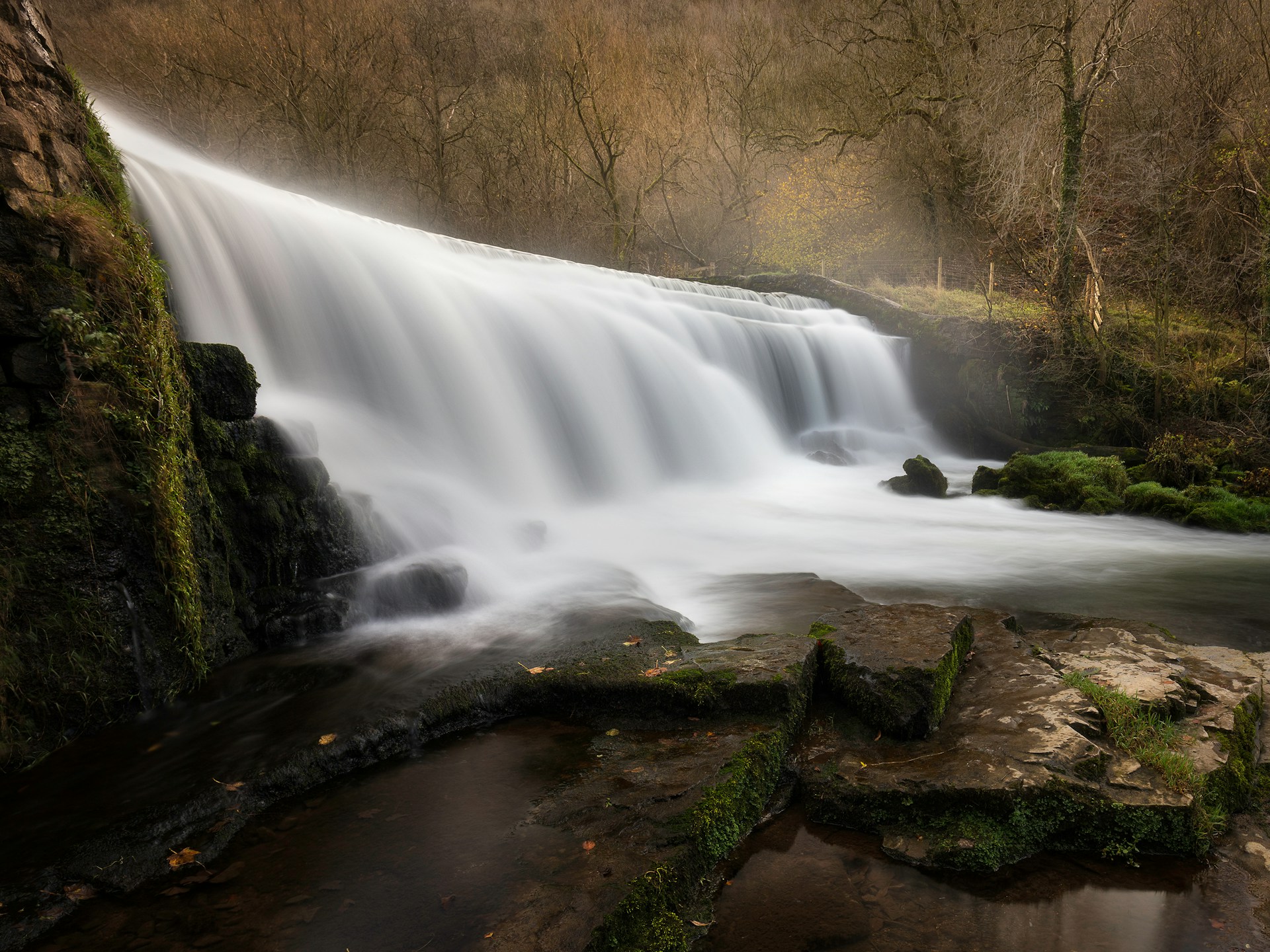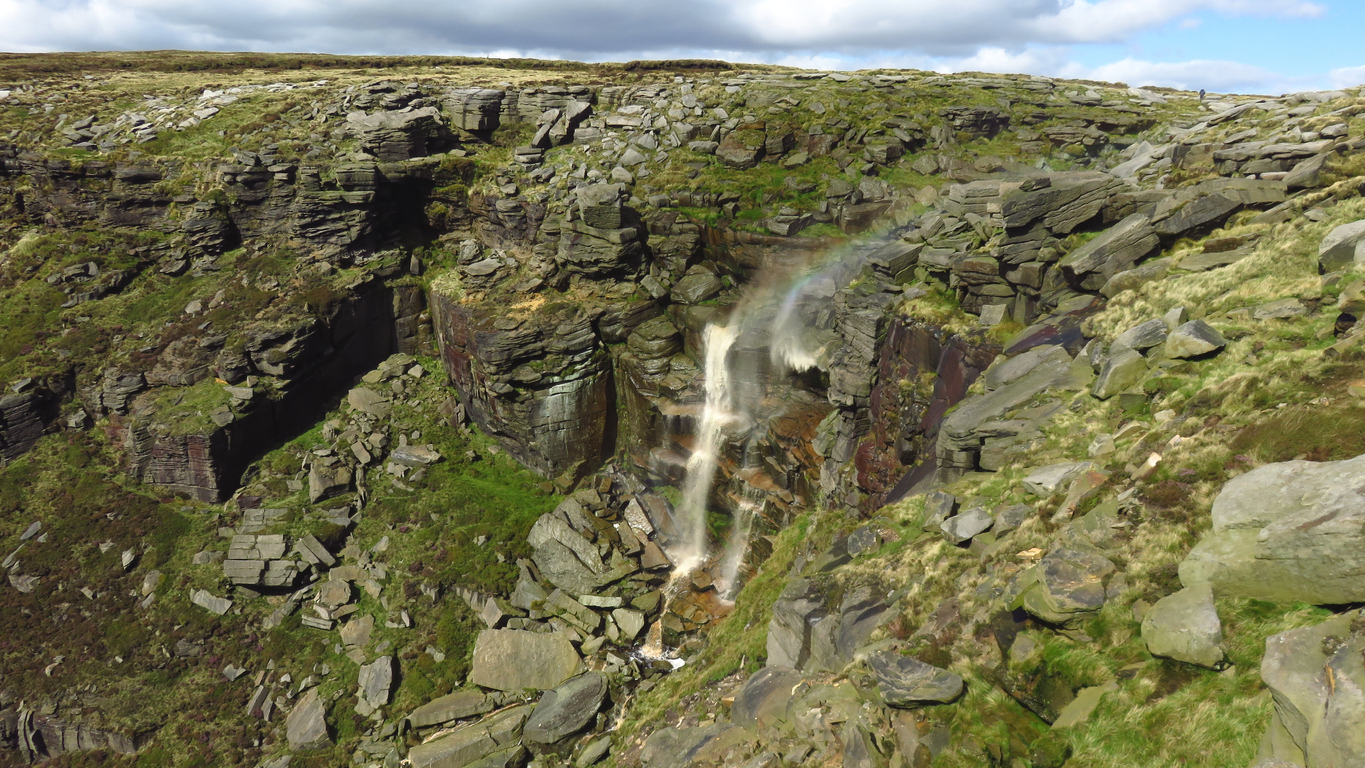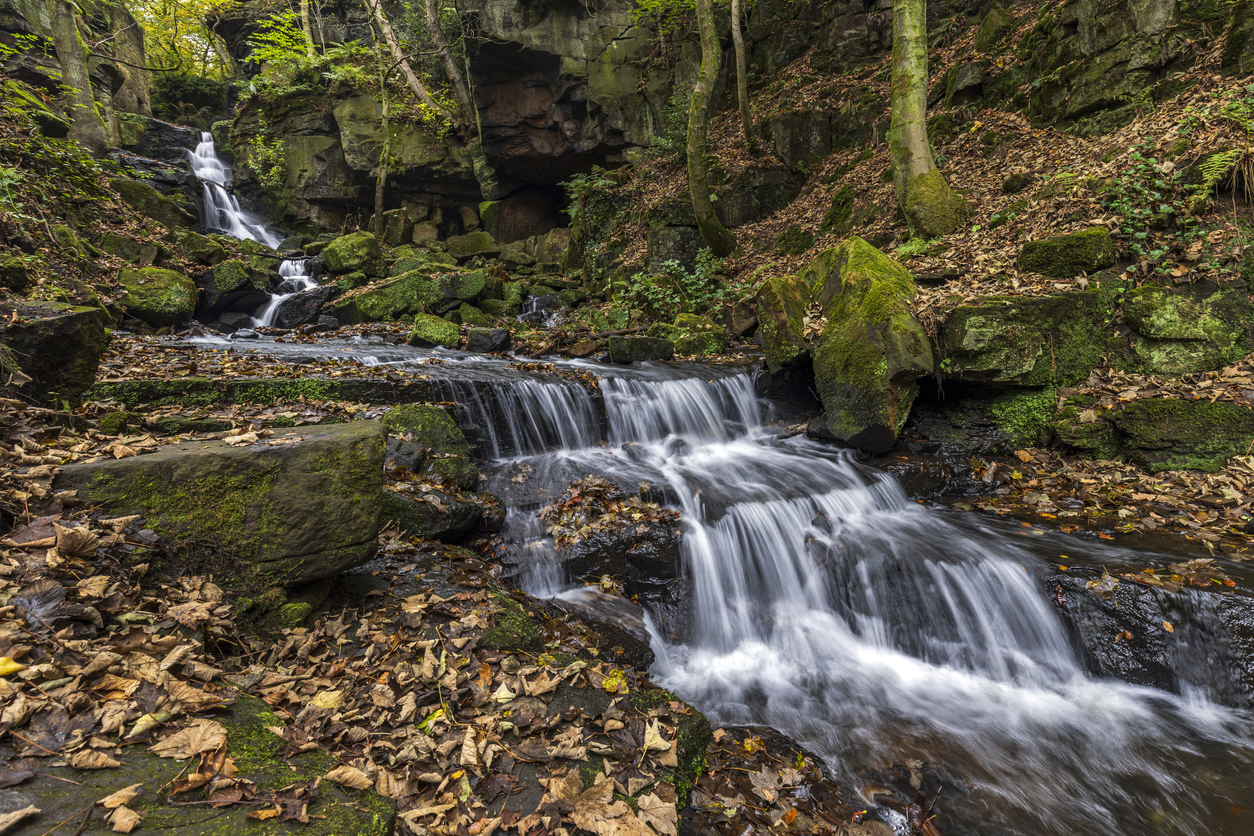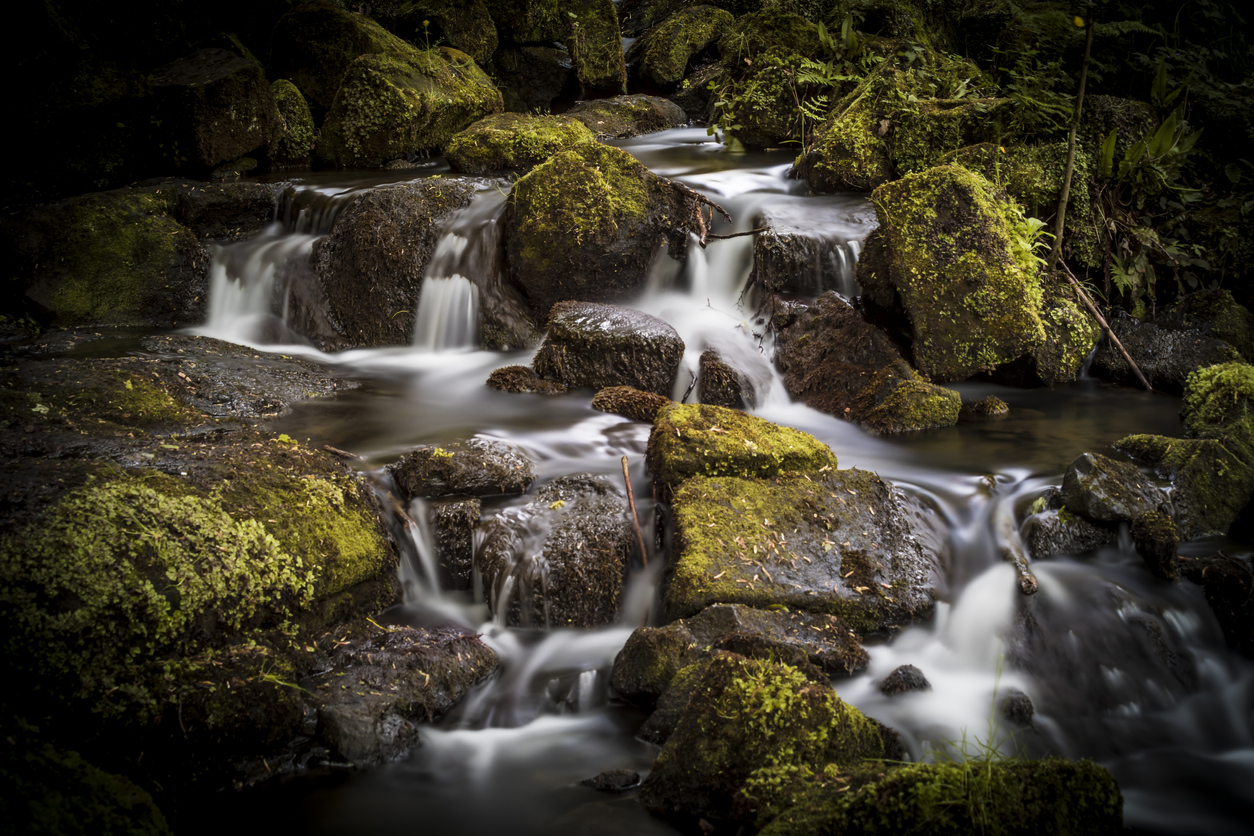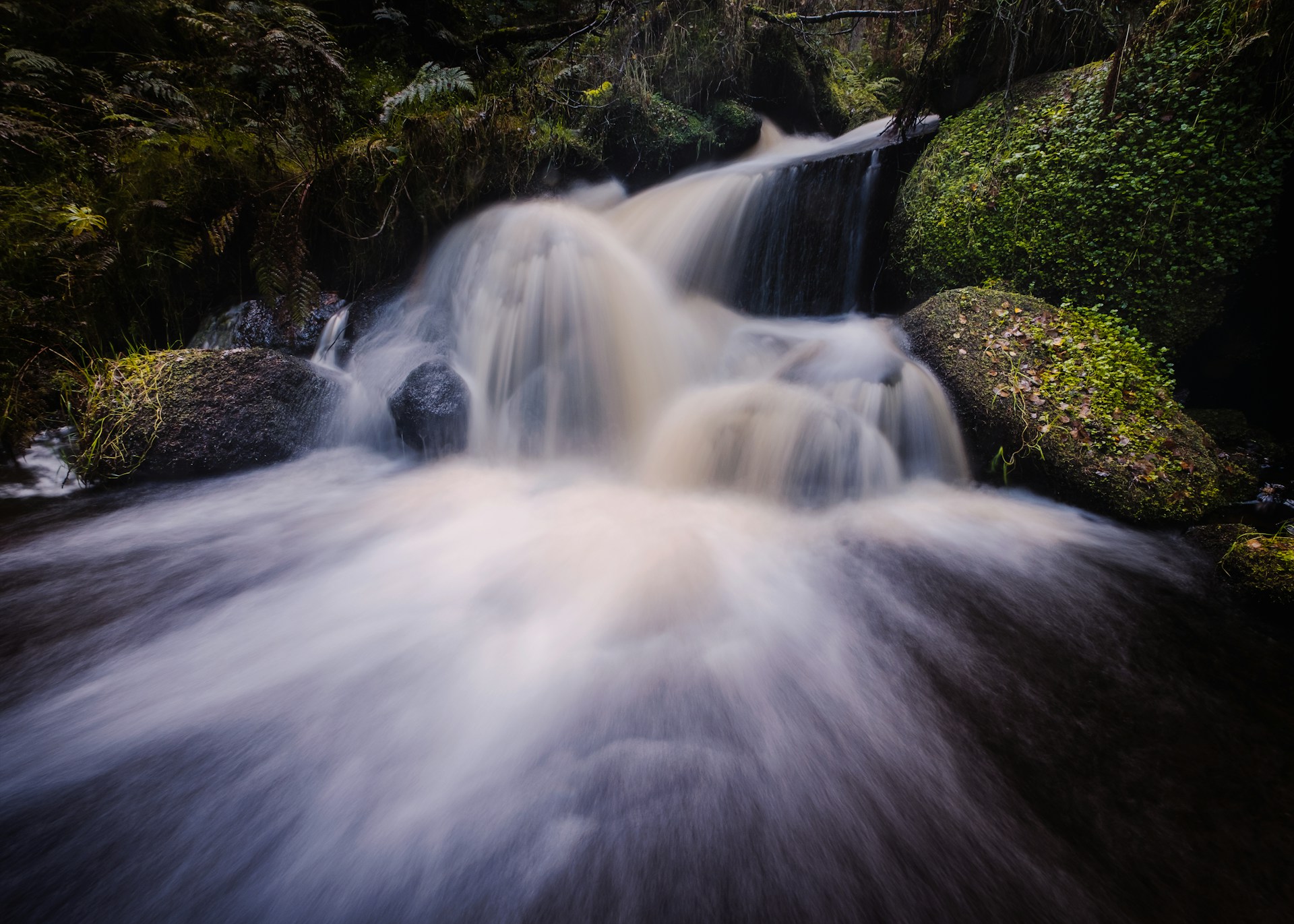The Peak District National Park, situated in central England, is famed for its rolling hills, brooding moorlands and atmospheric gritstone edges that attract hordes of walkers. However, one of the Peak District’s best kept secrets is the diversity of dramatic waterfalls hidden within its river valleys and forested glens. Over 20 named waterfalls are scattered throughout the moors and dales of the Peak District, ranging from delicate veils of water to thundering torrents cascading over cliffs.
The unique geology of the Peak District has created the perfect conditions for waterfalls to form. Much of the landscape consists of thick permeable limestone sitting atop harder impervious gritstone and shale. As rainfall filters through cracks and voids in the limestone, it reaches the base layer of gritstone which is resistant to water. Trapped at this boundary, the water then flows laterally through the limestone geology until it reaches a river valley or gorge. Here, the water cascades over the edge as a waterfall, creating mesmerising Austria and Switzerland scenes amidst the Peak District moorlands.
The high annual rainfall of the Peak District, coupled with changeable weather, adds drama to many of the waterfalls. Seasonal variations in flow rate are remarkable, with most transforming from gentle summer trickles to raging winter torrents. Some falls even freeze solid during cold winters, creating spectacular tiered icicles. This seasonal variety makes most waterfalls worth visiting in different weather conditions to fully appreciate their range. When rainfall swells river levels, the roar of water can be heard long before falls are visible, building suspense for their reveal around the next bend.
The walking routes to discover breathtaking yet often remote Peak District waterfalls vary from easy low-level trails to more challenging hikes with steep ascents. However, accessing tumbling cascades always feels more adventurous than the main tourist destinations. Along their paths lie relics of the Peak District’s industrial past like abandoned quarries and renovated mills which hint at lost communities. Interpretation boards explaining this heritage enlighten walks just as much as admiring nature's simple yet captivating water-carved rock forms swirling in plunge pools.
Kinder Downfall - Peak District's Tallest Waterfall
At 30 metres tall, Kinder Downfall on the River Kinder holds the record for the loftiest waterfall in the Peak District National Park. It also ranks amongst the highest cascades in England. This famous waterfall forms an abrupt broken cascade, with the main single drop dividing into twin falls separated by a central gritstone buttress when water volume decreases. After heavy rain, Kinder Downfall positively thunders, carrying massive volumes that create dramatic cloud-like sprays of water. Its grandeur and remote beauty make it a highlight of the Peak District.
The Kinder Downfall Walk
The scale and drama of Kinder Downfall comes alive when viewed up close on foot. Starting from the old mill village of Hayfield, an excellent 8 kilometre circular walk first ascends the Pennine Way up the steeply stepped rocky clough onto Kinder Plateau. It then traverses the Mill Hill section of Kinder Scout along an escarpment with far-reaching views over the Kinder Reservoir filling a valley basin below.
The last mile heads uphill towards the Downfall itself. Suddenly its roar grows louder through the wind until the viewpoint is reached. Nothing prepares walkers for witnessing the waterfall's full spectacle head-on. It thunders over the clifftop, hurling huge white jets that billow outwards before the torrent lands in its soak zone. Spray floats on the breeze to refresh observers, the vibrant greens of ferns and moss lining Kinder Downfall's plunge pool glistening from its soaking.
When planning this walk, check forecasts for high winds which can deflect the Downfall's flow upside down - a bizarre natural phenomenon! Countless photo viewpoints along the escarpment capture the ribbon waterfall against the wild moorland backdrop. The moderate 8km circuit takes around 3 hours but could last all day with photography stops. Its scale makes Kinder Downfall a definite walk highlight when exploring the Dark Peak.
The History and Geology Behind Kinder Downfall
Kinder Downfall owes its imposing height and power to the unique Peak District geology. Much of the region consists of porous, permeable limestone overlaying thicker impermeable Millstone Grit rocks which form the Kinder Plateau. Water percolates easily through cracks in the limestone until it meets the gritstone base. Trapped on this non-porous surface, the water flows laterally through the limestone stratum until it cascades over the Kinder Scout cliffs as the Downfall.
This water erosion process of the gritstone rock band under the permeable limestone created the stepped profile of Kinder Scout's north-eastern edge. Kinder Downfall formed where the trapped water reaches and flows powerfully over the 30 metre clifftop. Seasonal variations transform its character from a gentle drizzle slicing the clifftops to an aggressive, bellowing deluge during winter floods. One fascinating phenomenon sees it even reverse flow briefly during exceptional gales!
Geological forces aside, Kinder Downfall's spiritual allure has made it a Peak District icon for centuries, long before national parks formalised landscapes. Its poetic name even inspired a folk song in 1832 about a doomed miller's daughter who drowned in its plunge pool. Now the erosion threat is from too many visitors rather than natural currents. Path repairs ensure future generations can also experience its elemental grandeur on departing from Hayfield.
Lumsdale Valley's Magical Waterfall Cascades
Concealed within a steep forested valley near Matlock lies Peak District gem known as the Lumsdale waterfalls. Over 2 kilometres, the River Lumsdale descends sixty metres through the heavily wooded gorge lined by towering gritstone cliffs. The valley contains around ten spectacular cascades ranging from fern-fringed veils 2 metres tall to the mighty force of Bateman's Leap plunging 20 metres off a clifftop into foaming pools fringed by lush vegetation. Its fairy tale-like quality makes the Lumsdale Valley a true hidden wonder.
Bateman’s Leap Waterfall
The absolute highlight along the magical Lumsdale Valley is Bateman's Leap Waterfall. Here twin powerful falls named Main Falls and Hidden Falls split before crashing 20 metres over a sheer sandstone cliff into a dark plunge pool, throwing up dramatic clouds of spray. Sites like this display Peak District waterfalls at their most spectacular, especially after heavy winter rainfall when they thunder loudly.
The remote quality of Bateman's Leap adds a romantic grandeur, as though from a Tolkien fantasy realm. Viewing platforms daringly approach the cliff edge for photography privileged to seem within reach of the heaving waters' grasp, yet still out of bounds enough for children to peer down under parents' careful watch rather than restrictive barriers. Lush ferns that thrive in its constant soaking cloak entire cliffsides and boulders around this active waterfall. Their vibrant emerald hues contrast magnificently with flecks of white water amidst dark grooves. Truly an exquisite vision where man hasn’t yet touched these timeless water-sculpted rocks swirling amidst roots and mosses.
The Lumsdale Valley History
Mill records date human habitation in the valley back to 1200 AD initially cleared for farming. But by 1600, twenty working water mills lined its wooded gorge, the fast-flowing river generating power for various rural industries. Weirs controlled water diversion along races powering mills for corn, bark, iron, leather tanning, cloth dying and brewing. Narrow sunken paths linked mill communities crammed into steep valley sides where tributary streams fed larger cascades.
By 1900 mills fell derelict as industry shifted into towns and steam replaced water. Lumsdale Mills perished under the infamous “Derbyshire neck” when new rail links exploiting larger rivers eclipsed small rural competitors. The mills lay abandoned for a century, the forest reclaiming its gorge although stepped weir cascades still flow through lush vegetation beside footpaths. Now Peak Park conservation protects Lumsdale Valley’s enchanting waterfall corridor as a lost world where industrial heritage still subtly blends into this quaint forested valley.
Dovedale’s Stepping Stone Waterfalls
Roughly halfway along Dovedale’s wooded limestone gorge, a spectacular cascade known as the Stepping Stone Falls descends 30 metres in a stairway of small waterfalls swirling into pools dotted amongst the ravine. After heavy rainfall, the Dovedale Stepping Stones transform into an impressive vision, with foaming white waters shooting over the rocky shelves under the canopy of trees lining the gorge.
These aptly named falls represent one of several cascades throughout the Dovedale gorge, making it arguably the Peak District valley with the greatest diversity of waterfall spectacles to discover. When the river is high, the sound of tumbling and roaring water bounces off the valley sides. Mossy platforms beside them offer places for quiet contemplation and riverside picnics.
Dovedale’s Circular Walk
The 9 kilometre Dovedale circular walk from picture-postcard Ilam village allows easy access to admire the valley’s most scenic waterfalls. Heading downstream it passes directly beside the Stepping Stone cascades before crossing the famous actual stepping stones over the River Dove. Here the walk divides, with an upper hill path leading back to Ilam Hall offering elevated vistas overlooking Dovedale’s waterfalls.
Alternatively continue downstream into Mill Dale section to reach more remote falls. Further spectacular cascades include Lover’s Leap and Dovedale Waterfall; a mesmerising rapid set amidst a convoluted rock chasm where waters funnel noisily into narrow channels and carved plunge pools. Quieter stepped falls line the riverside path almost all the way to quaint Thorpe Cloud village before looping back to Ilam village.
Stepping Stones History
The curious formations of the Dovedale Stepping Stones inspire debate regarding their origins. Some geologists suggest they formed through subsequent Ice Age freezing and thawing sculpting tiers along softer shale bands within the gorge’s limestone. However there are indications of early human enhancement balancing tourist safety with preserving aesthetic appearance. Pictures from Victorian times show fewer boulders obstructing direct views and access points to the waterfall.
Anecdotal evidence suggests stonemasons landscaped the stepped cascade into neater layers to delight visitors on Dovedale’s 83,000 annual tourist trips even 150 years ago. Steps assisted descent to the plummeting waters rather than rails so visitors could admire then engage with nature on her terms. And whilst Insta-culture today pressure landscapes into ever more photogenic compositions, Dovedale’s stepping stones display potential for sensitive human curation balanced with conservation even amidst immense tourism pressure.
Raven Tor Falls - Peak District's Most Remote Waterfall
Nestled deep within the Peak District forest valley of Lathkill Dale lies dramatic 30 metre high Raven Tor Falls, considered one of the most remote and spectacular waterfalls in the national park. After rainfall, huge volumes thunder over the sheer sandstone clifftop to send up clouds of spray, its power accentuated by the lack of fences or platforms in this natural arena. Below, its plunging white waters stand out brightly against rich forest greens lining the steep valley slopes.
Raven Tor's evocative name originates from the ravens nesting on the craggy tor summit, with no visible human buildings nearby to detract from the waterfall's wild grandeur. In every season, Raven Tor maintains an raw, untamed presence unmatched by more popular falls, its isolation and tricky access preserving a genuine pristine wildness. Venturing behind the pounding waters rewards intrepid walkers with exceptional views looking outwards from the steep rock amphitheatre.
Walk to Raven Tor Falls Starting Point
The 5 mile circuit walk revealing Raven Tor Fall's glory and remoteness begins from quaint Peak District village Millers Dale. Initially following the crystal clear River Lathkill along lush valley woodlands, it diverges uphill where a bridleway climbs gradually onto the heights of Little Longstone Edge. Panoramas unfurl over the patchwork fields and villages neatly nestling within the Derbyshire Dales below.
The walk later descends back into woods overlooking the deep gorge concealing the Lathkill's continuing journey. Tantalising glimpses across the void reveal white water streaks slicing down through the canopy as Raven Tor Falls crashes over 100 metres away across the valley. The lack of railings raises both vertigo and thrill of discovering the waterfall’s wild source. An exhilarating rough stone stairway descends the valley side into the trees, reaching slippery rocks beside the loud shear of immense power.
History and Geology
The craggy cliffs lining Raven Tor gorge reveal millions of years of natural quarrying by water erosion and Ice Age glaciers exposing the geology. Underlying layers of hard Millstone Grit channel the river over softer shales which then carve out rocky plunge pools undercutting the gritstone layer as tons of water perpetually pound over the clifftop unchecked by humans. Ironically, industrial history also left its mark nearby with relics of lead mines and Millers Dale quarry visible from the walk.
Yet beyond the power of its deep gorge, the mystery around exactly why Raven Tor waterfall itself formed on this otherwise gently sloping clifftop adds intrigue. One theory suggests softer veins of underlying toadstone gravel within the gritstone beds guides then releases occasional sudden waterfalls. But there are no visible signs or records historically suggesting Raven Tor cascade always existed, unlike better documented neighbours. Ultimately the romantic allure of its name matching the drama has secured this waterfall its almost legendary status as one of Peak District’s most inspiring forces of nature.
Stanton Moor's Hidden Cliff Waterfalls
Tucked away in a remote corner of the gritstone Stanton Moor plateau above Matlock Bath lies a surprising staircase of waterfalls cascading off an obscure clifftop and into the trees 100 metres below. An unnamed moorland stream tumbles over the 10 metre high wooded precipice in an ever-changing curve, scattering into a foaming pool between rocks. Despite lying just a 20 minute uphill walk from picturesque village Birchover, Stanton Moor's magical cascade feels like a secret oasis.
Further downstream, more stepped cascades shoot over flat sloping shelves lined by stone dams which create paddling pools swimmable after heavy rain. Their location encircled only by open moorland and pockets of trees bordering the plateau edge conjures a micro-world well off the beaten track. Seeking out Stanton Moor's waterfall spectacle forms part of an excellent 3 mile circuit walk revealing it’s alluring yet easily overlooked beauty.
The Stanton Moor Waterfall Walk
This moderately easy ramble begins from old lead mining village Birchover, following quiet lanes through forest then ascending steps onto Stanton Moor’s grassy expanse. Early spring sees shimmering yellow gorse blossom lining the stone wall marking the moor, replaced in summer by violet heather washed over by skylarks.
Weaving between rocky outcrops, the initial unnamed waterfall emerges into sight. Care is needed on the unguarded edges but views down the 10 metre plunging cascade fringed by Rowan trees are spectacular yet feel secretly exclusive. Halfway round, the walk reaches staircase flows slipping gently over stone shelves into paddling pool bliss on sunny days. There can be no more serene location to enjoy a riverside picnic than beside these soothing falls with just carefree birds for company.
Stanton Moor's Unique Landscape
This rewarding walk explores Stanton Moor’s unique landscape shaped over thousands of years by natural quarrying processes and Bronze Age man. The weird formations of weathered gritstone strata at the Cork Stone and Cave Stone resemble outsize human body parts. Boulders were manoeuvred into settings for ancient ritual chambers whilst unusual markings signify a rare rock-carved map by Druids charting alignments.
Now the exposed plateau, 25 million years in the making, offering panoramas over patchwork Peak District vales heralds an elemental restart point. Red grouse dart between hardy grasses, heathers and stone outcrops lined by Rowan trees in a tableau eternally smoothed by the seasons yet touched by few humans. Stanton Moor’s lonely waterfall cascades, feeding these moorland streams represent nature’s continuing momentum as the highest gritstone edges slowly erode. Treading lightly to discover their subtle allure offers walkers footholds into lingering pockets of preserved wilderness.
Lyme Park Estate's Graceful Waterfall Cascades
Within the landscaped grounds of the National Trust’s Lyme Park lies the gracefully pretty Blackden Brook waterfalls. Two main cascades called Higher Falls and Lower Falls descend over a series of natural ridges and limestone steps, their gently flowing waters making soothing sounds as they ripple into clear plunge pools fringed by woodland.
These small yet perfectly formed falls shine subtly amidst the atmospheric forests surrounding Lyme Park’s grand country house. The walking trail linking the house to the serene Lyme Cage pond passes directly alongside the Lower Cascades, their steady babble accentuating tranquil isolation. For photography, dappled sunlight sparkling on their descending flow makes even the Estate’s smaller waterfalls appear quite special.
The History of Lyme Park House
Lyme Park's magnificent house commands the estate from atop a hill with views over the Cheshire Plain. Its origins as a Tudor manor later transformed into an elegant Georgian mansion reflected the changing fortunes of owners through history. Luckier heirs added grand extensions like the vast Library. While Civil War sieges saw it evolve into a formidable stronghold.
Disastrous 20th century fires and abandonment left the house an empty shell by 1980. Controversially vetoed for demolition, Lyme was saved by public donations and intensive repairs. Filming as Pemberley in the iconic 1995 BBC Pride and Prejudice series cemented Lyme Park’s status as the Nation’s grandest Peak District mansion. The house’s lavish interiors and surrounding formal gardens contrast wonderfully with the unspoilt natural woodlands.
Walks In Lyme Park
Entry fees to access the Hall, garden and deer park offer everything from easy waterfall walks to all-day hikes. Short trails like the 1 hour Cascade Ramble follow the water's journey down Blackden Brook's pretty staircases below beech tree canopies. Longer walks summit the estate’s high points revealing views over Manchester to Liverpool from rugged gritstone edges, evidence of Lyme’s special geological faultline creating such diverse landscapes side-by-side. Through it all, the Blackden Falls represent graceful jewels to discover en route.
The Allure of Peak District Waterfalls
The Peak District has rightfully earned its reputation for sweeping gritstone edges, heather moorlands and quaint villages. However, within its hidden wooded valleys lies a wealth of tumbling waterfalls equally inspiring yet more peaceful to discover. Over 20 named falls are scattered throughout the national park, ranging from powerful iconic cascades like Kinder Downfall to delicate staircases on obscure brooks.
Seeing Peak District waterfalls invariably involves scenic walking routes along rivers and through forests. Interpretation boards dotted at renovated mills and abandoned mines unveil the area’s heritage of generations working the landscape during the industrial era. Now nature has reclaimed these off-the-beaten-track valleys in the national park, with only relics like stepped weirs hinting at their past importance as water sources.
Visiting any waterfall creates a moment to pause and appreciate raw untamed nature at its simple glorious best. Their steady roar drowns out modern noise and brings a focused mindfulness upon the present. Watching mesmerising swirls of water eternally carving out rocky plunge pools transports walkers into the cycle of millions of years sculpting Britain's landscape. Preserved valleys like Dovedale and Lumsdale showcase our precious natural jewels. More simply, the childlike joy of paddling in crystal streams beside smaller cascades brings out everyone’s inner explorer!
When planning waterfall walks, check conditions and allow extra time between photo stops. Decent footwear enables scrambling behind torrents while swimming kits let visitors embrace water’s chilled purity. Seek out cascades in different seasons to witness nature’s seasonal shifts from trickling ice sculptures to raging white fury. Then through their trees and rocky outcrops, the Peak District reveals itself as a secret waterfall wonderland every bit as magical as better-known mountain vistas abroad.
Related articles

Let us know you agree to cookies
We use marketing, analytical and functional cookies as well as similar technologies to give you the best experience. Third parties, including social media platforms, often place tracking cookies on our site to show you personalised adverts outside of our website.
We store your cookie preferences for two years and you can edit your preferences via ‘manage cookies’ or through the cookie policy at the bottom of every page. For more information, please see our cookie policy.
